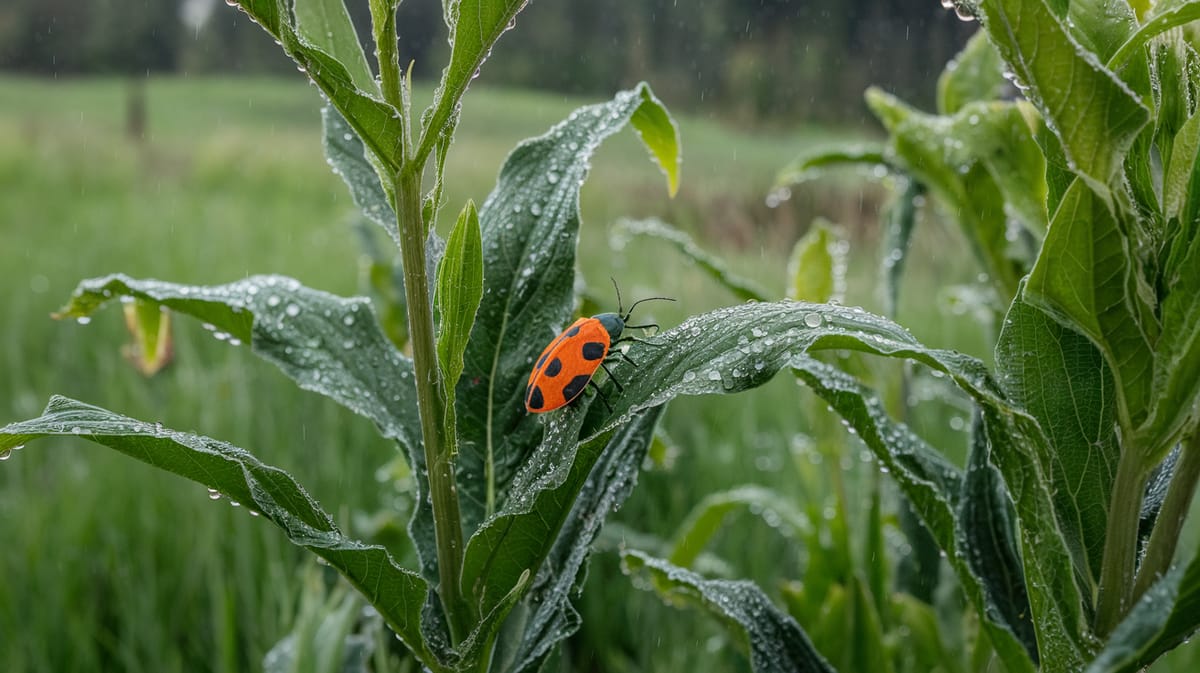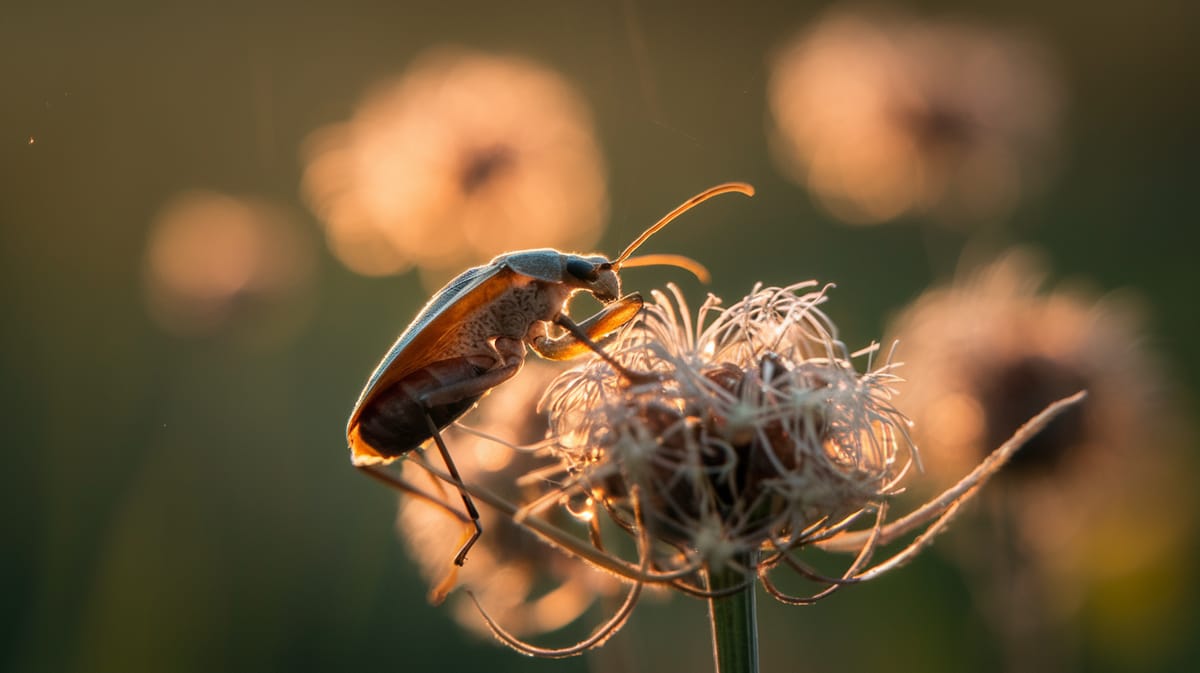Milkweed Bug
Vibrant in orange and black, the Milkweed Bug thrives on milkweed plants, playing a crucial role in their ecosystem by aiding in seed dispersal. Equipped with a unique chemical defense, it deters predators effectively.

Key Insights at a Glance
Did You Know?
Taxonomy & Classification
Milkweed bugs are specialized herbivores, adapted to feed on toxic milkweed plants, showcasing unique biochemical defenses and symbiotic relationships. Let's understand the evolutionary journey and classification of these remarkable herbivores.
Species Diversity
Milkweed bugs belong to the genus Oncopeltus, which includes about 11 species, each adapted to specific milkweed varieties across various regions.
Evolutionary Adaptations
Evolving approximately 20 million years ago, they developed resistance to milkweed toxins, enabling them to thrive where other insects cannot.
Lifecycle and Growth
A remarkable journey of transformation from Egg to Adult.
Egg
Laid in clusters, these pale orange eggs hatch into nymphs, dependent on temperature and environment for development.
Nymph
Nymphs resemble miniature adults, molting five times as they grow, developing black and red color patterns.
Adult
Adults display distinct black and red markings, feed on milkweed, and reproduce, laying eggs to continue the cycle.
Dietary Habits
A specialist feeder with unique adaptations, this insect primarily consumes the seeds of milkweed plants, utilizing its piercing mouthparts efficiently.
| DIET TYPE | DESCRIPTION |
|---|---|
| Primary Diet | Predominantly feeds on milkweed seeds, extracting nutrients directly using its specialized rostrum. |
| Secondary Diet | Occasionally consumes other plant seeds and sap when milkweed is scarce, displaying dietary flexibility. |
| Occasional | Rarely feeds on nectar or small insects, adapting to limited resources in its environment. |

Behaviour and Adaptations
Discover the fascinating adaptations that help the Milkweed Bug thrive in its environment.
Toxic Defense
Consumes milkweed to accumulate toxins, deterring predators with bright warning colors.
Seed Sap Feeding
Uses specialized mouthparts to extract nutrients from milkweed seeds.
Thermal Regulation
Basks in sunlight to regulate body temperature and maintain activity levels.
Ecosystem Impact
Milkweed Bugs play a crucial role in maintaining ecological balance through their interactions with plants and other organisms.
Seed Disperser
Milkweed Bugs help disperse seeds by feeding on milkweed plants.
Food Chain Component
Serve as prey for birds and other insects, supporting biodiversity.
Plant Health Indicator
Their presence indicates milkweed population health, aiding in ecosystem monitoring.
Conservation Challenges
Understanding and addressing the major threats to Milkweed Bug populations.
Pesticide Exposure
Pesticides disrupt milkweed bug populations, affecting their reproductive success.
Habitat Destruction
Urbanization and agriculture reduce milkweed availability, crucial for their survival.
Climate Variability
Changing climates alter milkweed growth patterns, impacting food sources.
Frequently Asked Questions
How long do Milkweed Bug live?
Milkweed Bugs typically live for about one month. Their lifespan includes different stages: egg, nymph, and adult. The duration can vary based on environmental conditions, availability of food, and other factors.
What do Milkweed Bug eat?
Milkweed Bugs primarily feed on the seeds, leaves, and stems of milkweed plants. They extract nutrients using their specialized mouthparts to pierce the plant tissues. They can occasionally feed on other plants, but milkweed is their main food source.
Are Milkweed Bug poisonous?
Milkweed Bugs are not poisonous to humans, but they do contain toxic compounds from the milkweed plant. These compounds make them distasteful to predators, providing a chemical defense mechanism. Handling them is generally safe, though washing hands afterward is advised.
Are Milkweed Bug endangered?
Milkweed Bugs are not considered endangered. They are relatively common and can be found in various regions across North America. Their population levels are stable, and they have a strong association with milkweed plants, which are also widespread.
What do Milkweed Bug symbolize?
Milkweed Bugs often symbolize transformation and adaptability due to their life cycle and association with milkweed plants. They are sometimes seen as symbols of resilience, as they thrive on plants that many other insects cannot tolerate.
Do Milkweed Bug bite?
Milkweed Bugs do not bite humans. They have piercing mouthparts designed to feed on plant juices, not for biting or stinging. They pose no threat to people or pets and are generally harmless when handled gently.
What color are Milkweed Bug?
Milkweed Bugs are bright orange or red with black markings. Their distinct coloration serves as a warning to predators about their unpleasant taste due to the toxic compounds they ingest from milkweed plants. This coloration is a form of aposematic or warning coloration.
Does a Milkweed Bug have wings?
Yes, adult Milkweed Bugs have wings. They possess two pairs of wings: the forewings, which are partially hardened, and the hindwings, which are membranous. These wings enable them to fly short distances in search of food or mates.
What does a Milkweed Bug look like?
Milkweed Bugs are small, with a vibrant orange-red body featuring black markings. They have a narrow shape, long legs, and antennae. The nymphs are similar but lack wings and are more uniformly colored. Their striking appearance is easily recognizable.
Is a Milkweed Bug an insect?
Yes, a Milkweed Bug is an insect. It belongs to the order Hemiptera, commonly known as true bugs. Like other insects, it has six legs, a segmented body, and undergoes metamorphosis. Its distinctive features include a proboscis for feeding and a bright coloration.
Related Insects
Discover insects with similar characteristics to Milkweed Bug - including shared habitats, diets, and taxonomic classifications
Share this profile
Help others discover Milkweed Bug
